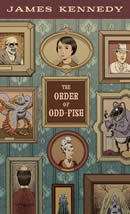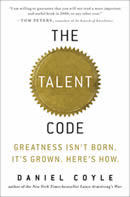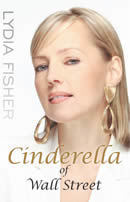
In James Kennedy’s young adult fantasy novel, The Order of Odd-Fish, the narrative follows an anarchic path as it tells the tale of Jo, a young girl discovering her heritage as an Odd-Fish squire.
One of the story’s many digressions is the history of The Very Polite War and the invention of the Apology Gun, “which can shoot up to 300 apologies per second,” one character notes.
Odd-Fish reaches its climax at the Dome of Doom, where fighters battle in front of a rowdy crowd after dressing down each other with elaborate insults. An example: “I am Aznath, Silver Kitten of Deceit, and my meow is your death sentence; my purr, your despair; my litter box, your grave!”
Widely praised, the book by Kennedy ’95 was a Smithsonian Notable Book for Children in 2008. Time Out Chicago described it as "a work of mischievous imagination and outrageous invention.”
The book is only one outlet for Kennedy’s inventiveness. After the book hit the market, he turned his creativity toward promoting his book.
Consider the event he engineered this past spring, which ultimately attracted about 250 people, Kennedy says. Held at a Chicago art gallery, the event featured about 100 pieces of artwork produced by fans of the book.
In the gallery, he also replicated the book’s Dome of Doom. Instead of actually fighting and insulting each other, the competitors, dressed in costumes inspired by the book, did a dance-off — and the more absurd the gyrations, the better the chance of winning.
In an online video promoting the Dome of Doom event, Kennedy dressed in an absurd get-up that he described as The Pink Tickler of the Apocalypse and “battle-danced” on screen.
His may be an extreme case, but Kennedy’s antics are emblematic of what authors go through these days in promoting their books. Like Kennedy, such Notre Dame graduates as Daniel Coyle ’87, Lydia Fisher ’77 and James King ’77 are finding promoting their books almost as challenging as writing them.
The publishing industry’s traditional methods of supporting new books have disappeared in the past decade, driven in part by the rise of the Internet and the communities it can foster so inexpensively.
“In the past, there was the author tour in a lot of cases — not every case,” says Jane Dystel, founder of Dystel & Goderich Literary Management and perhaps best known as Barack Obama’s literary agent. “But many authors came to expect that. There was the book signing, again set up by the publisher. And the authors came to expect that. That is almost not happening at all.”
Dystel adds: “It has to do with the fact that publishers have cut back enormously.”
In 2009 book sales by U.S. publishers totaled $23.9 billion, a 1.8 percent decline compared with the previous year, according to the Association of American Publishers. Even though the market has bounced back this year with sales up 11.6 percent through May, many publishers remain risk averse and are reluctant to boost marketing dollars.
“Once the book becomes successful, the publisher will jump in and start advertising,” Dystel says. “But not until then.”
These days, it’s up to the authors to market themselves and their books. “It really behooves the authors to promote the hell out of their books,” Dystel says.
Building buzz

Daniel Coyle’s first book, Hardball, which was about Little League baseball played in the shadow of high-rise projects in Chicago, was published in 1993. The book was made into a movie starring Keanu Reeves in 2001.
Since Hardball’s publication, Coyle has seen many changes in book marketing. “When I think about when my first book came out, I visualize the book sort of bobbing around a big ocean with a bunch of other books,” he says. “In the old days there used to be these luxury liners that would pick up your books. There was TV, radio and newspapers, and you’d sort of orient yourself to try to get picked up by one of those.”
He adds: “That model is sort of going through a transition. Now you have to build your own raft and hope that people hop on. It’s a different model. It’s more do-it-yourself. It’s definitely more about connectivity, which has its own pluses and minuses to it.”
With well-received books such as Lance Armstrong’s War on his resume, Coyle still gets picked up by the “luxury liners” of the mainstream media. But with his current book, The Talent Code, Coyle has embraced the Internet and created TheTalentCode.com website.
The site features a “trailer,” a short online video for the book. In it he talks about the misunderstood concept of talent and argues that people can learn exceptional skills if only they are taught properly. He demonstrates the concept by showing how, after only minutes of practice a day for a few months, he learned to juggle a golf ball on a pitching wedge a la Tiger Woods.
He also writes a blog, has a Facebook page and a Twitter account. Fans can email him via his website. He likes this newfound interactivity. “The more feedback the better,” he says.
A big break

Coyle had his first book deal before he was 30. James King ’77 was 55 and had a handful of rejected novels in his desk drawer before his big break, which came courtesy of the Internet.
“I’d been getting a lot of rejections,” King says. “I happened to see a blog post by an agent, who was talking about this contest. So I decided to check it out, certainly not thinking it would go anywhere.”
The contest was the 2009 Amazon Breakthrough Novel Award. King entered his latest work, Bill Warrington’s Last Chance, to go up against about 10,000 other entrants. “I was thinking maybe I’d get some feedback,” he says.
The feedback was pretty good. King won the contest. First prize included getting his novel published — it was released in August by Viking — as well as some praise from the judges.
“Perhaps one of the best things you can say about a novel is that the story lingers after you finish it. I have gone on thinking about this one without trying,” Sue Monk Kidd, author of The Secret Life of Bees, said about King’s book.
Although King has a brief book tour lined up for this fall, he — somewhat reluctantly — sees the value of using the digital world to promote his book. For his freelance writing business, King already had started a blog called The Business of Writing. His posts now are often promoting new developments with his novel. “A lot of people are used to talking about themselves,” he says. “Coming from a big Irish Catholic family, I’m not. So this is a little challenging.”
He acknowledges that writers from Oscar Wilde to Norman Mailer (Advertisements for Myself) have been masterful self-promoters as well as gifted storytellers. King is trying to embrace the salesmanship that may be even more necessary in today’s world of bookselling.
In a recent blog post, he writes about how he has finally found himself in his father’s shoes as a salesman, a job that King as a teenager found “as unsavory a career as one could choose.”
However, he writes, “And now that my novel is about to be released, what’s on my mind? Figuring out how to get people to buy it. Getting it reviewed, getting it mentioned on blogs, getting others to talk about it . . . whatever it takes to persuade people that it’s worth plunking down their hard-earned money for a copy.”
King remains ambivalent about the kind of self-promotion enabled by the Internet. “It’s a mixed blessing,” he says. “The new media gets you in touch with a lot of people, but it’s very time-consuming. And it’s tough to balance my freelance work with trying to write the second novel.”
Print on demand

Lydia Fisher ’77 had no problems diving into the world of commerce after graduating from Notre Dame. Over the past two decades as she worked for a handful of famed Wall Street investment banks, including Bear Stearns, Goldman Sachs and Salomon Brothers, she had no designs on writing a book.
But when Bear Stearns collapsed in March of 2008, presaging the recession, her career on Wall Street came to a sudden close. In the months after the demise of her firm, she reflected on her career and the changes in the financial industry that allowed the disaster to occur. The more she thought about it, the more she felt a pull to communicate her experience in the financial sector.
“I felt a calling to write this book,” she says.
She spent about a year writing a memoir called Cinderella of Wall Street. She published the book herself through a print-on-demand operation and now markets her book via the web in a variety of ways.
She opted for actual printed copies, even though e-books are fast becoming a viable alternative. Consider that Amazon.com said that in June it sold 180 books for its Kindle e-reader for every 100 hardcover books it sold.
Fisher’s printer even helped create the website for her book. She accepts orders through the site. She regularly scans the online business networking site LinkedIn, looking for conversations where she can perhaps provide a comment. She says she doesn’t overtly sell the book but looks to merely contribute to the conversation.
The Internet swamp
Compare that sort of dignified networking to Kennedy’s willingness to take a pratfall. In addition to his Dome of Doom dance party, Kennedy, who has studied improv comedy in the past, staged a farcical performance at an American Library Association conference in July 2009.
Invited to speak, Kennedy used the opportunity to have a friend impersonate Neil Gaiman, who had won the Newbery Medal for The Graveyard Book earlier that year. As the actor playing Gaiman began to address the audience, Kennedy, playing himself, charged onto the stage and tackled him.
He then challenged Gaiman to a contest to see who truly deserved the Newbery. Kennedy later wrote about the stunt, “I stripped Neil Gaiman of the Newbery award, winning it fair and square in a fantastic series of trials.” Word of the stunt reached Gaiman, who noted it on his own blog.
“I know that my sales went up because of that,” Kennedy says. “A lot of people who have read my book read it because of the Neil Gaiman shenanigans.”
It’s instructive to note how those “shenanigans” worked. The performance was amplified because it was videotaped and then posted to Kennedy’s website and to YouTube. Gaiman referenced the stunt online, and Kennedy saw a surge in Odd-Fish sales.
While acknowledging the role the Internet has played in his sales, Kennedy, who is a computer programmer by day, says half-seriously, “If I could take an ax to my computer, I would. I was able to do all this stuff because of the Internet browser, but it took over my life. It took a lot of time away from writing.”
Not all of it, however. Kennedy’s now working on The Magnificent Moots, a book about a family participating in the interplanetary Olympics. Perhaps one of his characters can figure out how best to win the book marketing game.
Sean Callahan is an editor at Crain Communications. He is also the author of several children’s books, including A is for Ara, A Wild Father’s Day and Shannon and the World’s Tallest Leprechaun.